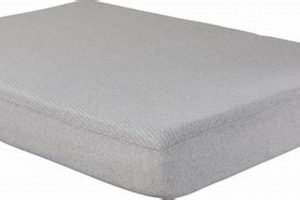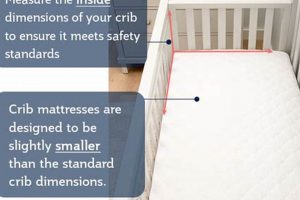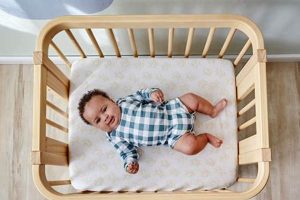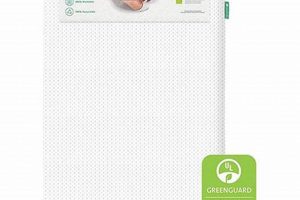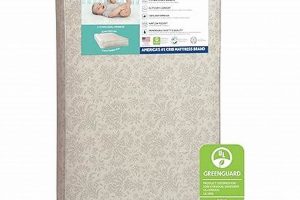Protective layers designed to encase a standard-sized baby bed sleeping surface provide a barrier against spills, allergens, and other contaminants. These items typically feature elasticized edges or fitted designs to ensure a snug and secure fit around the mattress. For example, a parent might choose a waterproof version to safeguard against accidents during the night.
Maintaining a clean and hygienic sleep environment for infants is crucial for their health and well-being. These coverings offer significant benefits by preventing the penetration of liquids, minimizing the growth of bacteria and mold, and reducing exposure to dust mites. Historically, the practice of protecting mattresses dates back centuries, with early versions utilizing basic fabrics to extend the lifespan of the underlying materials. Today, advancements in textile technology have led to the development of more sophisticated and effective solutions.
The subsequent sections will delve into the various material types, features, safety considerations, and care instructions related to these essential nursery accessories, offering guidance for selecting the most appropriate option.
Essential Considerations
Selecting the appropriate protective layer for a baby’s sleep surface requires careful consideration of various factors. This section provides guidance to aid in informed decision-making.
Tip 1: Material Composition: Prioritize options crafted from breathable, hypoallergenic materials such as organic cotton or bamboo. These minimize the risk of skin irritation and promote airflow, contributing to a comfortable sleep environment.
Tip 2: Waterproofing Technology: Opt for versions featuring a waterproof membrane, ideally one that is also breathable. This prevents liquids from penetrating the mattress while allowing air circulation, reducing the potential for mold and mildew growth.
Tip 3: Secure Fit: Ensure the selected item exhibits a snug and secure fit around the mattress. Loose or ill-fitting models can pose a suffocation hazard. Verify that the elasticized edges are robust and capable of maintaining tension.
Tip 4: Certifications and Standards: Look for certifications such as OEKO-TEX Standard 100, which indicates that the product has been tested for harmful substances. Adherence to relevant safety standards provides assurance of product safety.
Tip 5: Ease of Cleaning: Choose options that are machine washable and dryer-safe for convenient cleaning. Frequent washing is essential for maintaining hygiene and preventing the build-up of allergens.
Tip 6: Seam Construction: Examine the seam construction for durability and resistance to tearing. Reinforced seams contribute to the longevity of the product and its ability to withstand repeated washing.
Tip 7: Consider a Backup: Having a spare readily available is advisable. This allows for immediate replacement in the event of accidents or during laundering, ensuring uninterrupted protection.
Adhering to these guidelines contributes significantly to creating a safe, hygienic, and comfortable sleep environment for infants. Prioritizing quality and safety features is paramount when making this important purchasing decision.
The following section will address common concerns and maintenance procedures related to baby bedding protection.
1. Waterproof Barrier
The presence of a waterproof barrier is a defining characteristic of many baby bed sleeping surface protectors and is directly linked to the product’s functionality and efficacy. Without this feature, the underlying mattress is vulnerable to absorbing liquids, including bodily fluids, spills, and other contaminants. This absorption creates a breeding ground for bacteria, mold, and mildew, leading to unsanitary conditions and potential health risks for the infant. A real-life example would be an infant experiencing reflux; without a waterproof barrier, the mattress would quickly become soiled and potentially unusable. The inclusion of this barrier is therefore not merely an added benefit but a fundamental requirement for maintaining a hygienic sleep environment.
The practical significance extends beyond hygiene. A waterproof barrier significantly prolongs the lifespan of the mattress itself. Mattresses are typically costly items, and constant exposure to moisture can degrade the internal materials, leading to premature wear and tear. Furthermore, the ease of cleaning offered by a waterproof surface greatly simplifies the maintenance process for caregivers. Spills can be easily wiped clean, minimizing the need for extensive cleaning procedures. This ease of maintenance directly translates to time savings and reduced stress for parents and guardians.
In summary, the waterproof barrier is an indispensable component of these protectors, acting as a primary defense against unsanitary conditions and extending the longevity of the mattress. While challenges exist in balancing waterproofing with breathability, advancements in materials science continue to improve the effectiveness and comfort of these essential items. The selection of a protector with a robust waterproof barrier is a crucial step in ensuring a healthy sleep environment.
2. Breathable Material
The integration of breathable material in baby bed sleeping surface protectors is critical for regulating infant body temperature and minimizing the risk of overheating, a significant factor in Sudden Infant Death Syndrome (SIDS) prevention. Non-breathable materials can trap heat and moisture, creating a microclimate conducive to thermal stress. Breathable fabrics, such as organic cotton or bamboo, facilitate air circulation, allowing excess heat and moisture to dissipate, thereby maintaining a more stable and comfortable sleep environment. For example, an infant sleeping on a non-breathable surface during warmer months is at increased risk of overheating compared to an infant sleeping on a breathable surface. The choice of material, therefore, has a direct causal effect on the infant’s thermal well-being.
The practical significance of understanding the role of breathable material extends to the selection and use of these protective layers. Caregivers should prioritize options explicitly labeled as breathable and made from natural fibers known for their air permeability. Furthermore, layering should be minimized to prevent the trapping of heat beneath multiple layers of bedding. Regular monitoring of the infant’s temperature, particularly during sleep, is essential. This knowledge empowers caregivers to make informed decisions about bedding choices and create a safer sleep environment. The importance lies in recognizing that these protections are not merely aesthetic additions, but rather integral components of infant safety.
In summary, the utilization of breathable material in these products is paramount for infant thermal regulation and SIDS prevention. The challenges lie in balancing breathability with waterproofing and durability. Ongoing research and advancements in textile technology are continuously improving the performance of these materials. The emphasis on breathable material reinforces the broader theme of prioritizing safety and well-being in all aspects of infant care.
3. Secure Fit
The concept of a secure fit, as it pertains to baby bed sleeping surface protectors, transcends mere convenience, serving as a critical safety parameter directly influencing infant well-being. An improperly fitted protector introduces potential hazards, necessitating a comprehensive understanding of its implications.
- Suffocation Risk Mitigation
A loose or poorly fitted item can bunch or detach from the mattress, creating folds or gaps in which an infant could become entrapped, leading to potential suffocation. A snug, secure fit eliminates these potential hazards by maintaining a smooth, taut surface. Real-world examples include instances where ill-fitting sheets or protectors have contributed to infant entrapment and subsequent suffocation. The implications are severe, underscoring the paramount importance of proper fit.
- Reduced Risk of Entanglement
Excess material stemming from a loose fit presents an entanglement hazard. An infant’s limbs could become entangled in the excess fabric, restricting movement and potentially compromising circulation. Securing the item tightly against the mattress minimizes the amount of loose material, thereby reducing this risk. For instance, a protector with overly elasticized edges that do not grip the mattress securely can create slack, posing an entanglement threat. The direct consequence of this is a safer sleep environment.
- Maintenance of Mattress Integrity
A secure fit contributes to the even distribution of weight and pressure across the mattress surface. Loose or shifting protectors can cause localized stress on specific areas of the mattress, potentially leading to premature wear and tear. By maintaining a consistent and stable interface, a secure fit helps to preserve the integrity and lifespan of the mattress itself. An example would be a protector that slides around on the mattress, causing one area to bear more weight and thus deteriorate more rapidly. The maintenance benefits are therefore significant.
- Consistent Protective Barrier
A secure fit ensures the protective layer remains consistently positioned, preventing gaps or openings through which liquids or allergens could penetrate the mattress. If the protector shifts or bunches, the effectiveness of its waterproof or allergen-resistant properties is compromised. For example, a protector that frequently slips off a corner of the mattress creates an opening for spills to seep through. Consequently, a secure fit directly maintains the effectiveness of the protective barrier, upholding hygiene and mattress protection.
In summary, a secure fit is not merely a desirable attribute but an essential safety feature of baby bed sleeping surface protectors. By minimizing suffocation and entanglement risks, preserving mattress integrity, and maintaining a consistent protective barrier, a secure fit significantly contributes to a safer and more hygienic sleep environment for infants.
4. Hypoallergenic Properties
The incorporation of hypoallergenic properties in baby bed sleeping surface protectors directly addresses the heightened sensitivity of infants to allergens. Infants possess developing immune systems, rendering them more susceptible to allergic reactions triggered by dust mites, pet dander, mold spores, and other common allergens that accumulate in bedding. Protectors labeled as hypoallergenic are typically constructed from materials that minimize allergen retention and prevent the proliferation of microorganisms. For example, a protector made from tightly woven microfiber fabric restricts the passage of dust mites, mitigating their impact on the infant’s respiratory system. The utilization of such properties has a direct causal effect on reducing the likelihood of allergic reactions, such as skin rashes, respiratory distress, and sleep disturbances.
The practical significance of this understanding extends to informed decision-making during the selection process. Caregivers should prioritize protectors specifically advertised as hypoallergenic and certified by reputable organizations. Furthermore, diligent maintenance, including regular washing in hot water and thorough drying, is crucial for maintaining the effectiveness of these properties. The choice to invest in a hypoallergenic protector represents a proactive measure to safeguard infant health and well-being. Regular vacuuming of the surrounding sleep environment, including the mattress itself, further minimizes the presence of allergens. Thus, hypoallergenic attributes are not merely marketing claims but rather essential components of a healthy sleep environment.
In summary, hypoallergenic properties are an integral aspect of baby bed sleeping surface protectors, mitigating the risk of allergic reactions in infants. The challenges lie in accurately assessing the effectiveness of various hypoallergenic materials and ensuring consistent maintenance practices. Continued research and transparent labeling practices are crucial for empowering caregivers to make informed choices. The emphasis on hypoallergenic properties aligns with the broader theme of creating a safe, hygienic, and comfortable sleep environment, prioritizing the unique needs of the infant.
5. Washable Design
A washable design, when integrated into baby bed sleeping surface protectors, directly addresses the inevitability of spills, accidents, and the accumulation of bodily fluids that occur during infancy. The capacity to easily clean these items is not a mere convenience but rather a necessity for maintaining a hygienic sleep environment. Consider, for example, an infant experiencing frequent regurgitation; the absence of a washable protector would necessitate frequent and cumbersome cleaning of the mattress itself, a process that is often ineffective and can contribute to mattress degradation. The presence of a washable design enables caregivers to quickly and efficiently remove contaminants, preventing the growth of bacteria and mold and minimizing exposure to allergens. The cause-and-effect relationship is clear: a washable design promotes hygiene; the absence of a washable design compromises it.
The practical significance of this feature extends to the long-term preservation of both the protector itself and the underlying mattress. Frequent laundering, facilitated by a machine-washable design, prevents the build-up of stains and odors, extending the lifespan of the protector. Furthermore, by containing spills and accidents, a washable protector prevents liquids from penetrating the mattress, protecting it from damage and prolonging its usability. The choice of materials and construction directly influences the effectiveness of the washable design. Durable fabrics and reinforced seams are essential for withstanding repeated washing cycles without compromising the protector’s integrity. Therefore, the selection of a protector with a robust washable design represents a prudent investment in both hygiene and longevity.
In summary, a washable design is an indispensable component of baby bed sleeping surface protectors, directly addressing the need for frequent cleaning and hygiene maintenance. Challenges remain in ensuring the durability and effectiveness of washable materials over repeated laundering cycles. Ongoing advancements in textile technology are continuously improving the performance of these washable protectors, reinforcing their importance in creating a safe and hygienic sleep environment for infants.
Frequently Asked Questions Regarding Crib Mattress Covers
The subsequent queries address common uncertainties concerning baby bed sleeping surface protectors, providing factual responses intended to clarify potential misconceptions.
Question 1: What defines a “waterproof” baby bed sleeping surface protector?
A waterproof protector possesses an impermeable layer that prevents liquids from penetrating the mattress. This layer is typically constructed from materials such as polyurethane or vinyl. Products labeled “water-resistant” offer a degree of protection but are not fully impervious to liquids.
Question 2: Are all baby bed sleeping surface protector materials inherently hypoallergenic?
No. While some materials, such as organic cotton and bamboo, exhibit inherent hypoallergenic properties, others may require specific treatments or processing to minimize allergen retention. Certifications like OEKO-TEX Standard 100 provide assurance that a product has been tested for harmful substances, including allergens.
Question 3: How frequently should a baby bed sleeping surface protector be laundered?
The protector should be laundered at least once a month, or more frequently if visibly soiled. Accidents and spills necessitate immediate cleaning. Adherence to the manufacturer’s washing instructions is crucial for maintaining the protector’s integrity and effectiveness.
Question 4: Can a standard-sized protector be used on any baby bed mattress?
No. It is imperative to select a protector specifically designed to fit the dimensions of the baby bed mattress. A loose or ill-fitting protector poses a safety hazard. Measurements should be verified prior to purchase to ensure a snug and secure fit.
Question 5: What are the potential risks associated with using a protector that is not breathable?
Non-breathable materials can impede air circulation, leading to heat retention and an increased risk of infant overheating. Overheating has been linked to Sudden Infant Death Syndrome (SIDS). Breathable materials, such as cotton or bamboo, are recommended to promote airflow and regulate infant body temperature.
Question 6: Do more expensive protectors inherently offer superior protection or safety?
Price does not always correlate with quality or safety. Factors such as material composition, waterproofing technology, certifications, and fit are more reliable indicators of a protector’s effectiveness. Thorough research and evaluation of product specifications are essential, regardless of price point.
Key takeaways include prioritizing safety, hygiene, and the correct fit when selecting a baby bed sleeping surface protector. Informed decision-making is paramount.
The subsequent section will address best practices for maintaining and caring for these protective layers.
In Conclusion
This exploration has underscored the vital role that baby bed sleeping surface protectors play in safeguarding infant health and safety. Key considerations include waterproof integrity, breathable materials, secure fit, hypoallergenic properties, and a washable design. A failure to prioritize these elements compromises the integrity of the sleep environment and potentially endangers the infant. These items are not optional accessories but rather essential components of a responsible nursery setup.
The ongoing commitment to diligent research, informed purchasing decisions, and consistent maintenance represents a fundamental responsibility for all caregivers. A child’s well-being is inextricably linked to the quality and safety of their immediate surroundings. Therefore, a continuous and unwavering focus on the selection and care of baby bed sleeping surface protectors is paramount, demanding vigilance and informed action to ensure a secure and hygienic sleep space.


